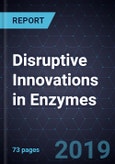Enzyme Technologies Facilitating Responsible Transition Towards Circular Economy
This research service, “Disruptive Innovations in Enzyme Technologies,” focuses on the leading technology and business trends that are making it possible to implement cutting-edge innovations that enable to face the present and future challenges of the bioprocessing and biomanufacturing sectors from an enzymology perspective.
The tendencies depicted in this study will help to drive the sustainability of the bioprocessing and biomanufacturing industries regarding the utilization of new biocatalyst technologies by directly exhibiting the major challenges faced by leading companies to develop new product modalities in an affordable and high-performance style, while getting market acceptance and achieving market leadership by translating technology innovation to market competitiveness.
An overview of the global enzyme market by type, source, and end application is discussed.
The study covers the following topics:
- Technology roadmap, trends, capabilities, and applications targeted
- Stakeholder activities, influence, industry initiatives, investment environment, and funding support
- Regional and global regulation landscape and standardization approaches for tackling challenges
- Technology benchmarking for smart decisions
- Market trends and figures








